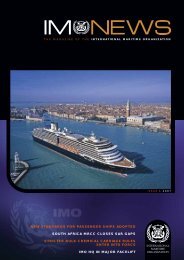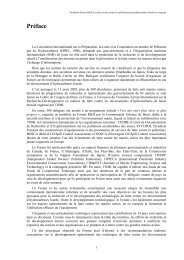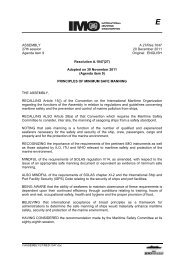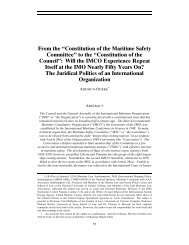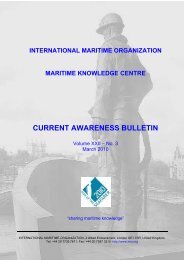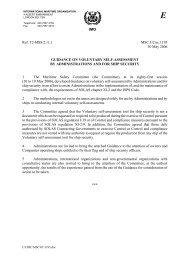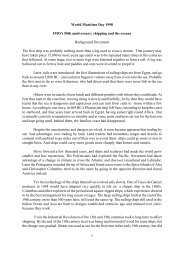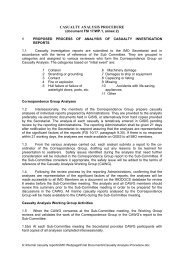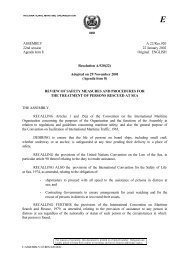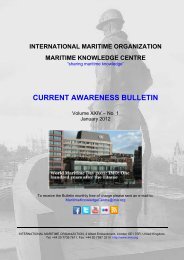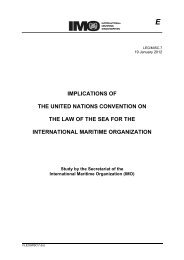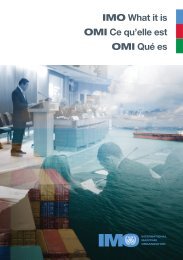Radioactive Waste Disposal at Sea: Public Ideas ... - IMO
Radioactive Waste Disposal at Sea: Public Ideas ... - IMO
Radioactive Waste Disposal at Sea: Public Ideas ... - IMO
Create successful ePaper yourself
Turn your PDF publications into a flip-book with our unique Google optimized e-Paper software.
122 Chapter 7<br />
and dynamism of you three [Commoner, Heyerdahl, and Hugh Downs]<br />
here this morning getting the <strong>at</strong>tention of the American public and in turn<br />
of our colleagues here in the Congress to move in the right direction” (Sen.<br />
Ernest Hollings, Intern<strong>at</strong>ional Conference on Ocean Pollution, p. 26).<br />
Members of Congress were keenly aware th<strong>at</strong> Cousteau, Heyerdahl, and<br />
other articul<strong>at</strong>e science celebrities and prominent, vocal scientists and ecologists<br />
played a critical role in identifying the need for regul<strong>at</strong>ion and establishing<br />
new norms for ocean protection. In short, they performed a crucial<br />
norm-setting role.<br />
Ecologists and environmentalists originally produced the ideas and concepts<br />
th<strong>at</strong> bound together the transn<strong>at</strong>ional coalition of policy entrepreneurs.<br />
But politicians were not passive consumers of ideas. Politicians<br />
themselves were actively involved in spreading policy-relevant ideas, and<br />
it is difficult to distinguish in a meaningful way among producers, consumers,<br />
and communic<strong>at</strong>ors of ideas. For example, Sen<strong>at</strong>or Gaylord<br />
Nelson, who first proposed U.S. ocean dumping regul<strong>at</strong>ion in Congress in<br />
February of 1970, wrote an article titled “Stop Killing Our Oceans,” which<br />
was published in Reader’s Digest (February 1971) and reprinted in the<br />
Congressional Record (Sen<strong>at</strong>e, February 8, 1971, pp. 2035–2036). 18<br />
The case of ocean dumping confirms the claims made in chapter 3 about<br />
the significance of the intellectual and contextual characteristics of ideas.<br />
Policy entrepreneurs chose to push an idea and target a problem th<strong>at</strong> corresponded<br />
with broad environmental concerns, whereas ideas th<strong>at</strong> questioned<br />
the seriousness of the marine pollution problem were releg<strong>at</strong>ed to<br />
political obscurity and survived only among scientists and in their professional<br />
journals. 19 The “dying oceans” idea was a strong value st<strong>at</strong>ement<br />
favoring a general need for protecting the marine environment. It expressed,<br />
in capsular form, a more comprehensive environmental value and belief<br />
system.<br />
It was a combin<strong>at</strong>ion of intellectual and contextual characteristics th<strong>at</strong><br />
made the “dying oceans” idea pervasive and powerful.<br />
First, the idea was (or <strong>at</strong> least could be) used to portray a large number<br />
of very different instances and degrees of contamin<strong>at</strong>ion and pollution.<br />
Rivers, lakes, estuaries, straits, seas, and oceans were repe<strong>at</strong>edly described<br />
as “dead” in this period. 20 In addition to the examples mentioned earlier, a<br />
part of New York Harbor was called “the Dead <strong>Sea</strong>,” 21 the Santa Barbara<br />
Channel was described as “a sea gone dead” after an offshore oil well



